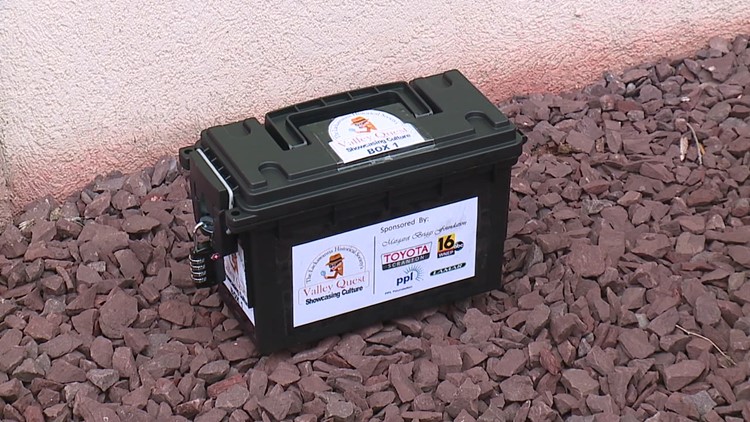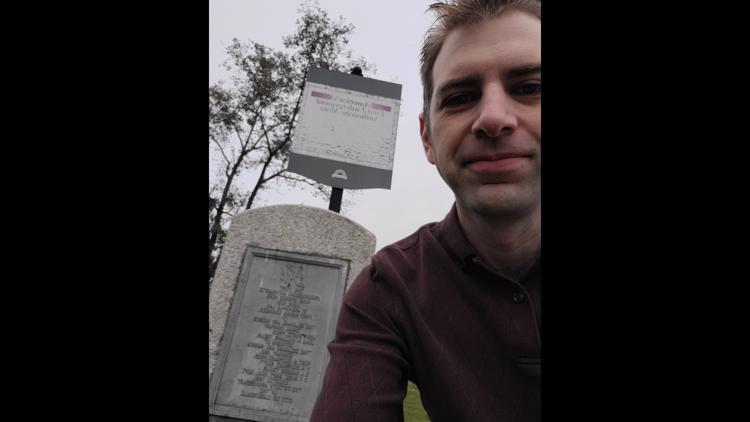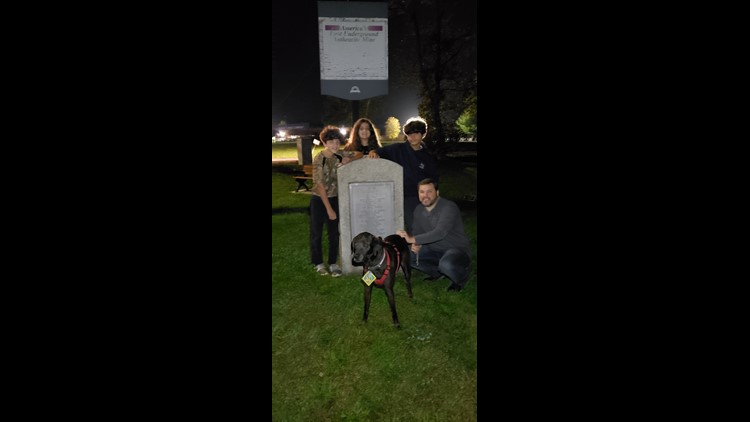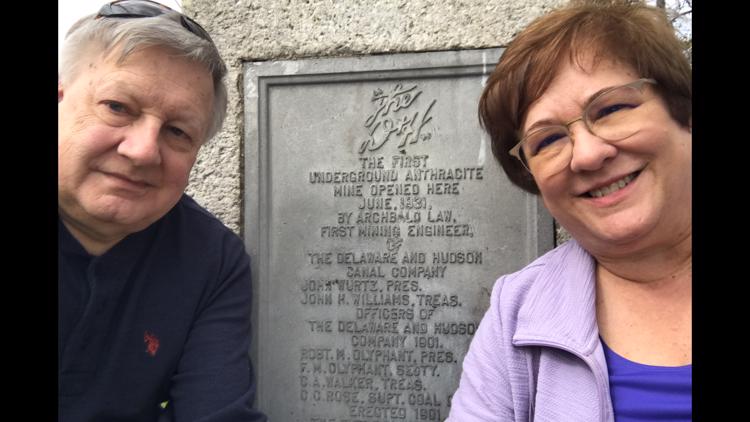LACKAWANNA COUNTY, Pa. — Historians in Lackawanna County are asking people in the community to hunt for the area's hidden history.
Anyone with a keen eye may notice discrete additions to their communities in Lackawanna County: Lockboxes hidden in places of historical significance.
They're waiting to be found this month by teams of scavenger hunters working with the Lackawanna Historical Society.
Searchers use weekly clues to find the lockboxes and then a combination to unlock the box for a prize symbolizing this part of the county's history.
Here are the latest clues:
Week 1
CLUE 1
St. Michael’s Orthodox Church, Jermyn
The Orthodox Church has a strong presence in the Lackawanna Valley. Immigrants from eastern Europe, including Russia, Ukraine, Czechoslovakia, and the region of the Carpathian Mountains, settled in the Lackawanna Valley after the 1880s, bringing their orthodox faith with them. Many of these early immigrants came to work in the anthracite coal mines in the late 1800s and early 1900s, adding to the rich tapestry of nations represented in Lackawanna County’s early days and continuing into the present.
Early settlers in Jermyn walked to St. John’s Russian Orthodox church in Mayfield before establishing their own parish. After founding a school in 1905, the first church was dedicated to St. Michael the Archangel in 1909. That church was destroyed by fire in 1915; the church the stands today was completed and consecrated in 1919. The church is a parish of the Diocese of Eastern Pennsylvania, Orthodox Church of America.
Please take a walk around the church, noting the beautiful, elaborate detail on the exterior with its domes and Orthodox cross, ornate doors and colorful painted tiles. This ornate structure is just one example of the artistic beauty seen in many Orthodox churches in our area.
CLUE 2
Carbondale City Hall
Carbondale has deep roots as the oldest city in Lackawanna County, which is reflected in the city’s nickname as the “Pioneer City.” Carbondale’s early immigrants came to mine anthracite coal for the Delaware & Hudson Canal Company, America’s first million-dollar corporation. St. Rose of Lima parish, the oldest Catholic church in Lackawanna County, was established by Irish immigrants in 1832. The city also had a thriving Jewish community, which established the Agudath Shalom (Society of Peace) synagogue on Pike Street in 1907. When the synagogue closed in the 1970s, the cornerstone was placed in a nearby Jewish cemetery in Childs. The cornerstone is just one piece of the city’s history that has been preserved, however. Recently, a Delaware & Hudson caboose was returned to City Hall and placed on tracks along the building, with hopes to turn it into a museum. The car serves as a link between the city’s past and future.
CLUE 3
Anthracite Park – Delaware and Hudson (D & H) 7th Avenue Crossing
This little-known monument marks the site of America’s first underground Anthracite shaft mine. Across the street is Wurts Lane, named after brothers Maurice and William Wurts, Philadelphia businessmen, who discovered coal in Carbondale in 1814. The brothers formed the Delaware & Hudson (D&H) Canal Company to transport coal from Carbondale to Honesdale and onward to New York City. The D&H was America’s first million-dollar corporation, helping fuel an industrial boom locally and across the Northeast.
For those who have little knowledge of coal geology, anthracite is the “cleanest” burning coal with the highest carbon content and heating value (BTU). Because it burns hotter than other types of coal, it has less volatile matter producing less smoke and soot. It also has less mercury and other pollutants than other types of coal. For all these reasons, one can see why the Wurts brothers and other entrepreneurs staked their claim in this marvelous discovery in the Lackawanna Valley.
CLUE 4
Greenfield Township One Room Schoolhouse – Carpenter School #6 –
This one room school house was in use until 1917, a remnant from a by-gone era. The building was originally located at Sickler’s Pond in Greenfield Township before it was moved to its current location. Adjacent to the school is a museum dedicated to this early history of the township filled with artifacts and memorabilia of the township’s early years. Officially founded in 1816, Greenfield Township grew at a consistent pace with the first tavern built in 1820, along with the first school. Take a step back in time and tour this interesting building, the only one of its kind in Lackawanna County. The schoolhouse and museum are open on the first and third Saturday and last Sunday of each month from 10:00 a.m. - noon.
CLUE 5
Hickory Grove Cemetery, Waverly
Hickory Grove Cemetery was founded in 1807 and is one of the earliest cemeteries in Northeastern PA holding African American graves. Named for the large grove of hickory trees surrounding the area, it was established on a 326-acre farm by Elder Miller, a Baptist preacher. Waverly, then called Abington Center, was a station on the Underground Railroad, with many homes offering a safe haven for escaping slaves. Many chose to settle in the area, establishing farms and businesses; the African Methodist Episcopal Church was established in 1844. At least 75 former slaves settled in Waverly by the end of the 19th century. Many are buried in Hickory Grove cemetery, including eight African American soldiers who voluntarily served the Union during the Civil War. Look along Row 5 for Ann Matilda Smith, a former slave who died in 1886; her tombstone reads, “Forty years a slave and now safe in the arms of Jesus.”
The Waverly Community House sponsors the Destination Freedom program, including guided and self-guided tours of Underground Railroad sites.
WEEK 2
CLUE 6
Moffat Estate, Covington Township
Around 1844, Dr. Charles Frischkorn, a German immigrant, settled in what is now Covington Township on a parcel of land purchased from Henry Drinker, a Philadelphia Quaker who received a 25,000-acre land grant as a reward for his service in the Revolutionary War. Dr. Frischkorn died in 1897, and his family sold the property in Atty. Michael J. Martin in 1926. Martin, an employee of the Moffat Coal Company, built a stately 17-room mansion on the property. In 1952, the estate was sold to Robert Y. Moffat, Sr., who made the estate their primary family residence. His son, Robert Y Moffat Jr., remained in the mansion until his death in 2002, leaving the house and 42-acre property to Covington Township for “educational,
cultural, scientific, passive recreational, natural, scenic, habitat, historic, architectural,
agricultural, water resource, open space and public purposes.” There is a conservation easement on the property in perpetuity. The Moffat mansion serves as township offices today; Frischkorn’s original home is now known as the caretaker’s house.
Across the street from the estate was the family home of colorful historical figure, Louis Bortree, a former sheriff, outdoorsman, and local legend. Bortree allegedly fired the first shots into a crowd of striking mine and iron workers during a labor strike in Scranton in 1877. Three men were killed; Bortree was part of a posse of industrialists led by W.W. Scranton who were all ultimately acquitted for their actions.
CLUE 7
Cortez, Mt. Cobb, Jefferson Township
Mt. Cobb was first settled around the year 1784 by Asa Cobb, a farmer who also operated a rest stop and tavern for travelers through the Cobb’s Gap area. One of the most impressive geographical features of Mt. Cobb is Moosic Mountain, also once called Cobb’s Mountain, elevation 2,100 ft, a prominent and scenic part of the Pocono Plateau. Named for the moose which once populated this area along with bear and many other animals, the mountain was transected by Indian trails connecting the Delaware and Lackawanna Rivers and points beyond. Indigenous peoples sent smoke signals from the top of the mountain often seen by those dwelling along the Lackawanna River in what is now Scranton.
There is a legend about the name Cortez that ties the region to revolutionary Mexican leaders. Legend says there was a plan in the 1860s to establish a Mexican colony in Winton, just across the mountain. The plan had the support of the Mexican general and former president Santa Anna, but the colony never materialized. The name Cortez would have forged a Mexican connection.
CLUE 8
Logan Memorial Cemetery, Throop
When most people think of Northeastern PA, they don’t usually associate the area specifically with Hungarian settlers. However, a substantial population of Hungarians, many belonging to the Magyar sect, settled in the region, most notably in the area now known as Throop Borough. Throop is named for Dr. Benjamin Throop, the first physician in the Lackawanna Valley and a Civil War surgeon; Dr. Throop invested heavily in coal and real estate, purchasing land to acquire coal rights in the borough that would bear his name.
In 1894, Dr. Throop donated a plot of land for a church for the Magyar Catholics living in the area. The church was part of a program begun by Dr. Samuel Logan to bring ethnic missionaries to the region who spoke native languages and could meet the spiritual needs of worshippers without a parish. In 1901, Dr. Logan preached a mass of thanksgiving at the church, celebrating the 50th anniversary of the arrival in America of Hungarian revolution Lajos (Louis) Kossuth. The parish cemetery is named in honor of Dr. Logan.
CLUE 9
Gravity Slope Colliery, Archbald
Very little remains of any structures highlighting the anthracite history of Lackawanna County. A rare exception are the remains of the Gravity Slope Colliery. The three existing buildings, the Shifty Shanty, the Fan House and the Oil House are an invaluable legacy from the age of Anthracite. During its heyday, over 1,200 men and 120 mules were employed there, many of them immigrants from Ireland and other countries who came to the region to start a new life.
Mining coal at this site began in 1845, at the White Oak Mine in what was then called
the “Dark Valley” section of Archbald Borough. The Delaware and Hudson Coal Company closed the White Oak breaker in 1911, and sent coal to the new breaker on the site for processing. The breaker was used until 1942; coal mined at the colliery was shipped to Carbondale or Scranton for processing. The mines at this site worked until 1955 when water began seeping into the mines and the Gravity Slope shut down for good.
Today, a neighborhood committee hopes to restore the remaining structures for use as a visitor’s center and museum. The Fan House contains an original Guibal Fan, which is only one of two remaining in the Anthracite region. This fan supplied air to miners through shafts connected to the mines below and is a rare artifact. The Shifting Shanty, the largest building on site, was the building where miners changed their clothes before and after their hard day’s work in the mines. The Oil House, the smallest structure at the entrance to the site, has been renovated by the Gravity Slope Committee to serve as a future meeting area or coffee shop.
CLUE 10
St. Ubaldo Society, Jessup
St. Ubaldo Baldassini (born 1084), the patron saint and bishop of the small town of Gubbio in the province of Umbria, Italy, has found a new home in Jessup. St. Ubaldo Day, or Festa dei Ceri, is held each May both here in Jessup and also in Gubbio, its sister city. St. Ubaldo saved the town of Gubbio from invasion by the conquering German army, by ascending into the mountains to meet with the invaders led by Frederik Barbarrossa. Although old and in poor health, Ubaldo secured the safety of the town, sparing it from destruction.
The traditional “Race of the Saints” was brought to Jessup in 1909, by Italian immigrants, homesick for their old Italian traditions, who began to celebrate with a race through the streets in which runners carry heavy platforms with statues of St. Ubaldo, St. Georgio (St. George) and St. Antonio (St. Anthony). St. Ubaldo always wins (of course) on the day filled with fun, revelry, good food, family and friends and more than a little Italian wine.
WEEK 3
CLUE 11
Washburn Street Cemetery, Scranton
The West Scranton neighborhood of Hyde Park was an ethnic Welsh enclave, representing the early-arriving population of immigrants who brought deep mining experiences with them from Wales. Hyde Park miners worked in nearby collieries or traveled to other parts of the coal region, wherever there was work. On September 6, 1869 a fire began at the Avondale colliery in Plymouth when the Steuben shaft caught fire from a furnace belowground and ignited the coal breaker above. This shaft was the only entrance and exit to the mine; all 108 miners suffocated from the smoke and flames, while two additional men died during ultimately futile rescue attempts. Avondale was the deadliest mining disaster to date, and spurred the Pennsylvania General Assembly to pass mine safety legislation, requiring all mines to have at least two points of access. The disaster, and a later jury decision that the fire was preventable, led many miners to join the Workingmen’s Benevolent Association, a fledgling union.
The Washburn Street cemetery is the final resting place of many men killed in the Avondale disaster. Inside the cemetery, take the first road to the left; here you will find 61 graves, many written in Welsh, of men and boys killed at Avondale, along with memorial markers.
CLUE 12
Islamic Center, Scranton
Historically, the Lackawanna Valley has been populated by immigrants who brought their culture, language, religion, and traditions with them. New immigrants continue to settle in the region, adding to our cultural patchwork. In Scranton alone, United Neighborhood Centers works with families representing 56 different countries! Many local residents are surprised to learn that there is a sizable community of Muslims in our area, and other Islamic Centers and mosques in Wilkes Barre and Stroudsburg as well.
The Islamic Center in Scranton is a “vibrant and inclusive community, reflecting the diversity of cultures and traditions of Muslims from around the world.” They promote understanding and cooperation of all people with diverse backgrounds and religious beliefs, stand firm against terrorism and religious extremism, and aim to serve the local community with initiatives and programs in education, the arts, culture, and recreation. Check out their website and Facebook page to learn more about this important heritage and tradition in our community.
CLUE 13
St Stanislaus Polish National Cathedral, Scranton
There’s a joke in the Lackawanna Valley that you’ll find a church and bar on every corner (and funeral home nearby), all catering to different, very specific ethnic groups. Yet even within these tight-knit ethnic communities, there were sometimes unsolvable differences. The Polish National Church is the outcome of a schism between Polish Catholics who disagreed about land ownership and the role of the laity in the church. In 1896, a group of dissenting parishioners from Sacred Hearts of Jesus and Mary in Scranton broke away, soon forming a new denomination under Rev. Francisek Hodur. Subsequently excommunicated by Bishop O’Hara, Hodur was consecrated as the first bishop of the Polish National Catholic Church in 1907. St Stanislaus Cathedral serves as the headquarters of the church, named after St. Stanislaus of Szczepanow, Bishop of Krakow, Poland, who was martyred in 1079.
Today, St. Stanislaus Cathedral remains the home of the central diocese of the Polish National Catholic Church, which has more than 26,000 members in the US, Canada, and Poland. The church teaches slight variations in Catholic doctrine and stresses a more democratic structure and involvement by church parishioners.
CLUE 14
Sweeney’s Beach, Scranton
The Lackawanna River Conservation Association (LRCA) has been instrumental in restoring Sweeney’s Beach, along the east bank of the Lackawanna River, into a recreational area, boat launch for kayaks and canoes, and public green space. The beach is the site of Riverfest and other community events throughout the year.
But did you know that Sweeney’s Beach was the site of a Native American settlement? The Delaware (Lenni-Lenape) under Chief Capoose settled near what is today Weston Field, with settlements and burial grounds throughout Providence and the Pinebrook neighborhood. This subgroup of the Delaware were called Minisi (Minisink), or the Wolf Tribe. The Minisink Trail was one of the most famous Indian trails in Pennsylvania, and one of the oldest roads in the country. It crossed Moosic Mountain and continued into points north and south. Although some artifacts were discovered from Capoose Village in the late 1800s, most of the settlement was destroyed by subsequent building in the area.
Take a stroll along Sweeney’s Beach. Even though there is no remaining evidence of Native American settlements along the current river’s edge, you can be sure that you are walking in the footsteps of our region’s earliest inhabitants. Stop and listen. Enjoy the beauty, the sights and sounds, that they would have seen over three hundred years ago in this restored natural area.
CLUE 15
Kosciuska Healing Garden, Scranton
Situated along the banks of the Lackawanna River in the Providence section of North Scranton, this memorial garden honors Revolutionary War hero Thaddeus Kosciusko (spelled Kosciuska in Lithuanian) and Lithuanian Americans who settled in our area, most of them coming here to work in the anthracite mines. Providence was once home to the largest community of Lithuanians in the city, so the Koscuiska Healing Garden pays tribute to these early immigrants. Although Thaddeus Kosciusko lived for many years in Poland, his background was Lithuanian. He was an avid gardener who constructed and maintained a small garden on the side of a cliff overlooking the Hudson River at West Point. His garden still offers a place for both cadets and visitors to relax and enjoy the tranquility of this beautiful area. It is, therefore, fitting that Lithuanians in our area should continue this tradition of a tranquil garden in our midst.
The Healing Garden was begun in 2006 in honor of Kosciuska and those Lithuanians who planted their well-maintained gardens along the Lackawanna River for many decades with numerous species of flowers including roses, lilacs, Rose of Sharon and other native flowers. The Healing Garden offers programs throughout the year, including programs on butterflies and native plants. A great honor was bestowed on the garden when the Lithuanian Ambassador to the United States, Rolandas Kriscuinas, visited the garden in 2018, dedicating a plaque to the Lithuanian American presence in our area.









